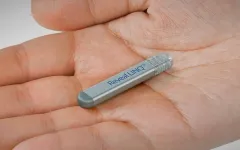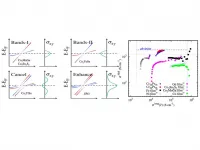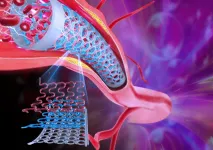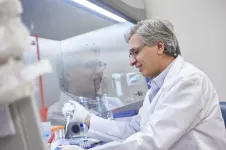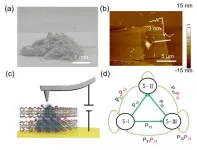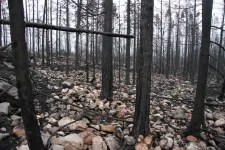(Press-News.org) A clinical trial examining the efficacy of two devices to monitor and detect atrial fibrillation (AF), or an irregular heartbeat, in ischemic stroke patients--one an implantable device that monitors over 12 months, the other an external device that monitors over a 30-day period--found the implantable device is more than three times more effective in detecting AF, and both are a significant improvement over the current standard of care in Alberta, Canada.
The Post-Embolic Rhythm Detection With Implantable Versus External Monitoring (PER DIEM) study, led jointly by University of Alberta and University of Calgary researchers, was published today in the journal JAMA. The findings are expected to significantly change practice in how clinicians look for AF in Albertan patients following ischemic stroke.
"We know that (the current method of monitoring) isn't as effective as it could be in picking up atrial fibrillation from this study because regardless of which arm of the study patients went into, we were picking up anywhere from five to 15 per cent extra atrial fibrillation," said Brian Buck, a stroke neurologist and associate professor of medicine at the U of A. "We found in the study there were a lot of patients with undetected atrial fibrillation, even after they received the standard cardiac monitoring."
Atrial fibrillation causes about one in four strokes in Alberta. Detecting it early is key to preventing further disabling strokes in patients who have already experienced ischemic stroke, a type of stroke caused by a blockage in an artery that supplies blood to the brain. If atrial fibrillation is detected, clinicians have treatments--mainly blood thinners--that can reduce the risk of stroke by almost 70 per cent.
The standard test in Alberta for AF is a 24-hour electrocardiogram monitor. In the PER DIEM trial, 300 Albertan patients who had suffered a stroke were randomized to one of two new devices that can monitor for AF for longer durations. The study showed that the implantable device picked up three times more new AF than the 30-day monitor (15 per cent versus five per cent). All of the patients in the clinical trial with new AF were started on blood thinners.
"We didn't expect that we would get such a dramatic increase with the longer recording, even though it intuitively makes sense," said study co-author Michael Hill, professor of neurology at the University of Calgary and senior medical director for stroke with Alberta Health Services' Cardiovascular and Stroke Strategic Clinical Network. "Most people suspected that detection rates apply to only certain subtypes of ischemic stroke. This study showed that theory is not correct."
"We believe that those patients that were identified with atrial fibrillation are now, for the rest of their lives, going to have a much lower risk of having a stroke in the future," added Buck, who is also a member of the U of A's Neuroscience and Mental Health Institute.
One of the patients who took part in the trial was Norman Mayer, the sitting mayor of the central Alberta community of Camrose for the past 32 years. Mayer recalls being admitted to the emergency department about five years ago after not feeling well and experiencing sudden pain. After examination, the clinicians on duty informed him that he had likely experienced a minor stroke.
After being stabilized, Mayer was informed of the clinical trial and given the option of participating. After giving his consent, he was randomly assigned to the group of patients who were given the implantable monitoring device.
"It was the luck of the draw, and the advantage of it was that it's inconspicuous and wearing (an external device) would not have been very appealing to me," said Mayer. "So I had (the implantable device) tucked into my chest. It's there and nobody knows about it except for me and my doctor.
"It gives you a bit of a comfort level, I guess. It's not bothering you. It's just there and a part of life," he added. "It gives you the feeling that if something was to go wrong, somebody's going to be in touch to let you know (what steps need to be taken)."
With better monitoring, clinicians may be able to diagnose much more AF after stroke and dramatically reduce the risk of future disabling stroke. According to the Canadian Coordinating Office for Health Technology Assessment (CADTH), the external device costs about $1,000 per patient to administer, while the implantable device typically costs over $5,000 per patient. The implantable device had the added advantage of remote monitoring, reducing the need for trips to the hospital--an important consideration for rural Albertans. The team says an in-depth cost-benefit analysis is needed to determine the best approach to providing superior care while also providing savings for the health-care system.
"The biggest problem with stroke is that it dramatically impacts people's lives. So you take a healthy, independent person with a big disabling stroke, and they often end up being dependent on others for help with care. So that's terrible for patients and it's very expensive for the system. If you can prevent even a few of those big disabling strokes per year, it helps the person and reduces the burden on the health system," said Buck.
"This new evidence will help guide selection of what strategy is best going forward," added Hill. "We need to go beyond (24-hour monitoring) for Albertan patients. But if the system is going to pay for this technology, we need to know more definitively that patients are going to end up with lower stroke rates in the future."
The researchers say studies to this point have shown a trend in that direction, but more work is needed to prove it definitively. They hope to address those questions in future research.
INFORMATION:
The PER DIEM study was conducted as one part of the overarching Performance Evaluation & Rhythm Follow-up Optimization with Remote Monitoring (PERFORM) project led by the University of Calgary's Derek Exner with the Libin Cardiovascular Institute. The research was funded through Alberta Innovates' Partnership for Research and Innovation in the Health System (PRIHS) program and in part through the Alberta Innovates CRIO grant program (QuICR Alberta Stroke Program). Industry partner Medtronic also gave in-kind support to the study.
The electronic structure of metallic materials determines the behavior of electron transport. Magnetic Weyl semimetals have a unique topological electronic structure - the electron's motion is dynamically linked to its spin. These Weyl semimetals have come to be the most exciting quantum materials that allow for dissipationless transport, low power operation, and exotic topological fields that can accelerate the motion of the electrons in new directions. The compounds Co3Sn2S2 and Co2MnGa [1-4], recently discovered by the Felser group, have shown some of the most prominent effects due to a set of two topological bands.
Researchers at the Max Planck Institute ...
Aerosol reductions that would take place as countries meet climate goals could contribute to global cooling and prevent more than one million annual premature deaths over a decade, according to a new study from the University of California San Diego.
The landmark Paris Agreement of 2016 does not address emissions of aerosols--fine particulates like soot that cause pollution. Nonetheless, findings from the recent study authored by researchers at UC San Diego's Scripps Institution of Oceanography and the School of Global Policy and Strategy suggests that aerosol accounting should be explicitly incorporated into international climate policy.
It is crucial because as countries implement their greenhouse gas reduction targets under the Paris climate agreement, ...
BOSTON - For patients who have experienced certain common types of stroke, a small chip inserted under the skin may help physicians predict their likelihood of experiencing a second stroke, and therefore their likelihood of benefiting from preventive therapy. The findings come from a recent clinical trial published in the END ...
From the biggest bridges to the smallest medical implants, sensors are everywhere, and for good reason: The ability to sense and monitor changes before they become problems can be both cost-saving and life-saving.
To better address these potential threats, the Intelligent Structural Monitoring and Response Testing (iSMaRT) Lab at the University of Pittsburgh Swanson School of Engineering has designed a new class of materials that are both sensing mediums and nanogenerators, and are poised to revolutionize the multifunctional material technology big and small.
The research, recently published in Nano Energy, describes a new metamaterial system that ...
Philadelphia, June 1, 2021--Researchers at Children's Hospital of Philadelphia (CHOP) have developed a proof-of-concept treatment for blood disorders like sickle cell disease and beta-thalassemia that could raise hemoglobin levels by activating production of both fetal and adult hemoglobin. Using a viral vector engineered to reactivate fetal hemoglobin production, suppress mutant hemoglobin, and supply functional adult hemoglobin, the researchers developed an approach that could produce more hemoglobin through a single vector. The results were published in Haematologica.
"Until now, researchers have been exploring one of two approaches to treating blood disorders ...
The discovery of graphene, a 2D layered form of carbon, once caused a paradigm shift in science and technology like no other. As this wonder material drew attention from material scientists around the world, it spurred research on other materials that were structurally similar, such as "van der Waals materials", which comprise strongly-bonded 2D atomic layers that are held together by weak interlayer interactions called "van der Waals forces". These materials quickly caught on because they were highly conducive to structural modifications, such as stacking, twisting, and insertion of foreign molecules between layers, which gave them interesting physical properties ...
Getting enough sleep can be a real challenge for shift workers affecting their overall health. But what role does being an early bird or night owl play in getting good rest? Researchers from McGill University find a link between chronotype and amount of sleep shift workers can get with their irregular schedules.
"Some people seem to be hardwired to sleep early, while others tend to sleep late. This preference, called chronotype, is modulated by our circadian system - each person's unique internal timekeeper," says lead author Diane B. Boivin, a Professor in the Department of Psychiatry at McGill University.
Their study published in Sleep is the first to examine the relationship between ...
Algorism plays a significant role in predicting future states of a system. Particularly, non-Markov chain algorithm has been widely applied in epidemic spreading processes, social and man-made memory networks, the environment-related quantum entangled states, and artificial algorisms such as face pose tracking. Traditionally, a large number of memories and computing cells are integrated to achieve these goals by software algorisms, showing high complexity. In the paper published in Science Bulletin, a group led by Bilu Liu and Hui-Ming Cheng from Tsinghua-Berkeley Shenzhen Institute (TBSI) of Tsinghua University has realized a non-Markov chain algorithm in a single resistive random access memory (RRAM) based on 2D mineral material ...
Swedish researchers from institutions including Uppsala University have spent four years gathering data from the areas affected by the major forest fire of 2014. In their study of how the ecosystem as a whole has been altered, they could see that water quality in watercourses quickly returned to normal, while forested areas continued to lose carbon for many years after the fire.
The consequences of major forest fires remain poorly studied in Northern Europe. To improve this situation, researchers from Uppsala University, the Swedish University of Agricultural Sciences (SLU) and the Swedish Meteorological ...
Siberian jays are group living birds within the corvid family that employ a wide repertoire of calls to warn each other of predators. Sporadically, however, birds use one of these calls to trick their neighbouring conspecifics and gain access to their food. Researchers from the universities of Konstanz (Germany), Wageningen (Netherlands), and Zurich (Switzerland) have now examined how Siberian jays avoid being deceived by their neighbours. The study, published in the journal Science Advances, shows that these birds have great trust in the warning calls from members of their own group, but mainly ignore such ...
